Investigating the Economic Impact of Cultural Tourism in Maldives
VerifiedAdded on 2023/06/12
|51
|14686
|135
Report
AI Summary
This report investigates the economic impact of cultural tourism in the Maldives, a nation heavily reliant on tourism. It examines the potential of cultural tourism to diversify the economy, create jobs, and improve the standard of living. The research explores the perspectives of Maldivian citizens on cultural tourism and analyzes factors affecting its growth. The study employs both qualitative and quantitative data to assess the industry's size, growth rate, and contribution to the GDP. Ultimately, the report aims to demonstrate the benefits of cultural tourism as a sustainable source of income and economic gain for the Maldives, while also acknowledging limitations and suggesting areas for future research. Desklib provides this assignment as a valuable resource for students studying tourism and economics.

Running head: BUSINESS RESEARCH METHODOLOGY
The economic impact of cultural tourism in the Maldives
Name of the student:
Name of the University:
Author note
The economic impact of cultural tourism in the Maldives
Name of the student:
Name of the University:
Author note
Paraphrase This Document
Need a fresh take? Get an instant paraphrase of this document with our AI Paraphraser
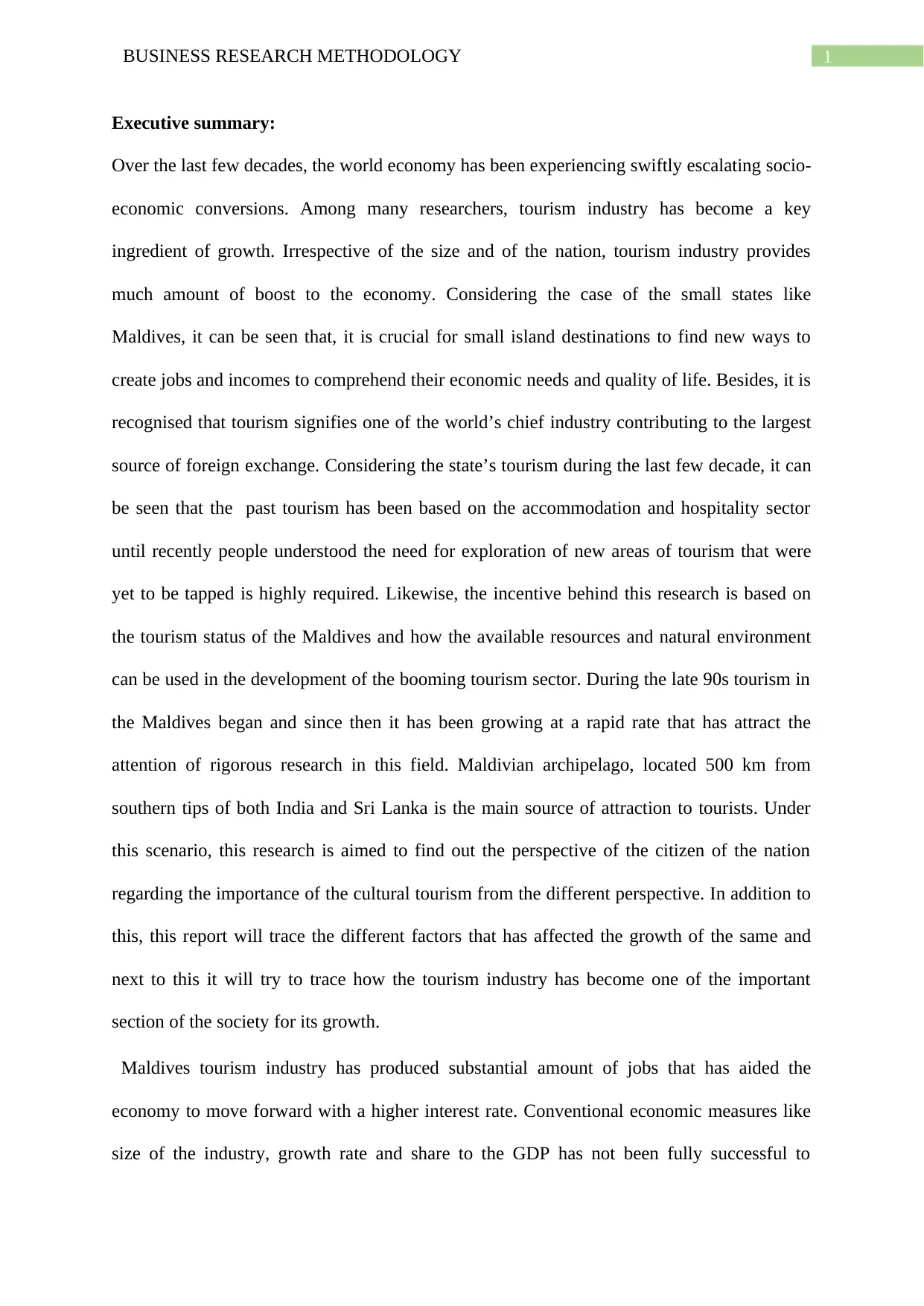
1BUSINESS RESEARCH METHODOLOGY
Executive summary:
Over the last few decades, the world economy has been experiencing swiftly escalating socio-
economic conversions. Among many researchers, tourism industry has become a key
ingredient of growth. Irrespective of the size and of the nation, tourism industry provides
much amount of boost to the economy. Considering the case of the small states like
Maldives, it can be seen that, it is crucial for small island destinations to find new ways to
create jobs and incomes to comprehend their economic needs and quality of life. Besides, it is
recognised that tourism signifies one of the world’s chief industry contributing to the largest
source of foreign exchange. Considering the state’s tourism during the last few decade, it can
be seen that the past tourism has been based on the accommodation and hospitality sector
until recently people understood the need for exploration of new areas of tourism that were
yet to be tapped is highly required. Likewise, the incentive behind this research is based on
the tourism status of the Maldives and how the available resources and natural environment
can be used in the development of the booming tourism sector. During the late 90s tourism in
the Maldives began and since then it has been growing at a rapid rate that has attract the
attention of rigorous research in this field. Maldivian archipelago, located 500 km from
southern tips of both India and Sri Lanka is the main source of attraction to tourists. Under
this scenario, this research is aimed to find out the perspective of the citizen of the nation
regarding the importance of the cultural tourism from the different perspective. In addition to
this, this report will trace the different factors that has affected the growth of the same and
next to this it will try to trace how the tourism industry has become one of the important
section of the society for its growth.
Maldives tourism industry has produced substantial amount of jobs that has aided the
economy to move forward with a higher interest rate. Conventional economic measures like
size of the industry, growth rate and share to the GDP has not been fully successful to
Executive summary:
Over the last few decades, the world economy has been experiencing swiftly escalating socio-
economic conversions. Among many researchers, tourism industry has become a key
ingredient of growth. Irrespective of the size and of the nation, tourism industry provides
much amount of boost to the economy. Considering the case of the small states like
Maldives, it can be seen that, it is crucial for small island destinations to find new ways to
create jobs and incomes to comprehend their economic needs and quality of life. Besides, it is
recognised that tourism signifies one of the world’s chief industry contributing to the largest
source of foreign exchange. Considering the state’s tourism during the last few decade, it can
be seen that the past tourism has been based on the accommodation and hospitality sector
until recently people understood the need for exploration of new areas of tourism that were
yet to be tapped is highly required. Likewise, the incentive behind this research is based on
the tourism status of the Maldives and how the available resources and natural environment
can be used in the development of the booming tourism sector. During the late 90s tourism in
the Maldives began and since then it has been growing at a rapid rate that has attract the
attention of rigorous research in this field. Maldivian archipelago, located 500 km from
southern tips of both India and Sri Lanka is the main source of attraction to tourists. Under
this scenario, this research is aimed to find out the perspective of the citizen of the nation
regarding the importance of the cultural tourism from the different perspective. In addition to
this, this report will trace the different factors that has affected the growth of the same and
next to this it will try to trace how the tourism industry has become one of the important
section of the society for its growth.
Maldives tourism industry has produced substantial amount of jobs that has aided the
economy to move forward with a higher interest rate. Conventional economic measures like
size of the industry, growth rate and share to the GDP has not been fully successful to
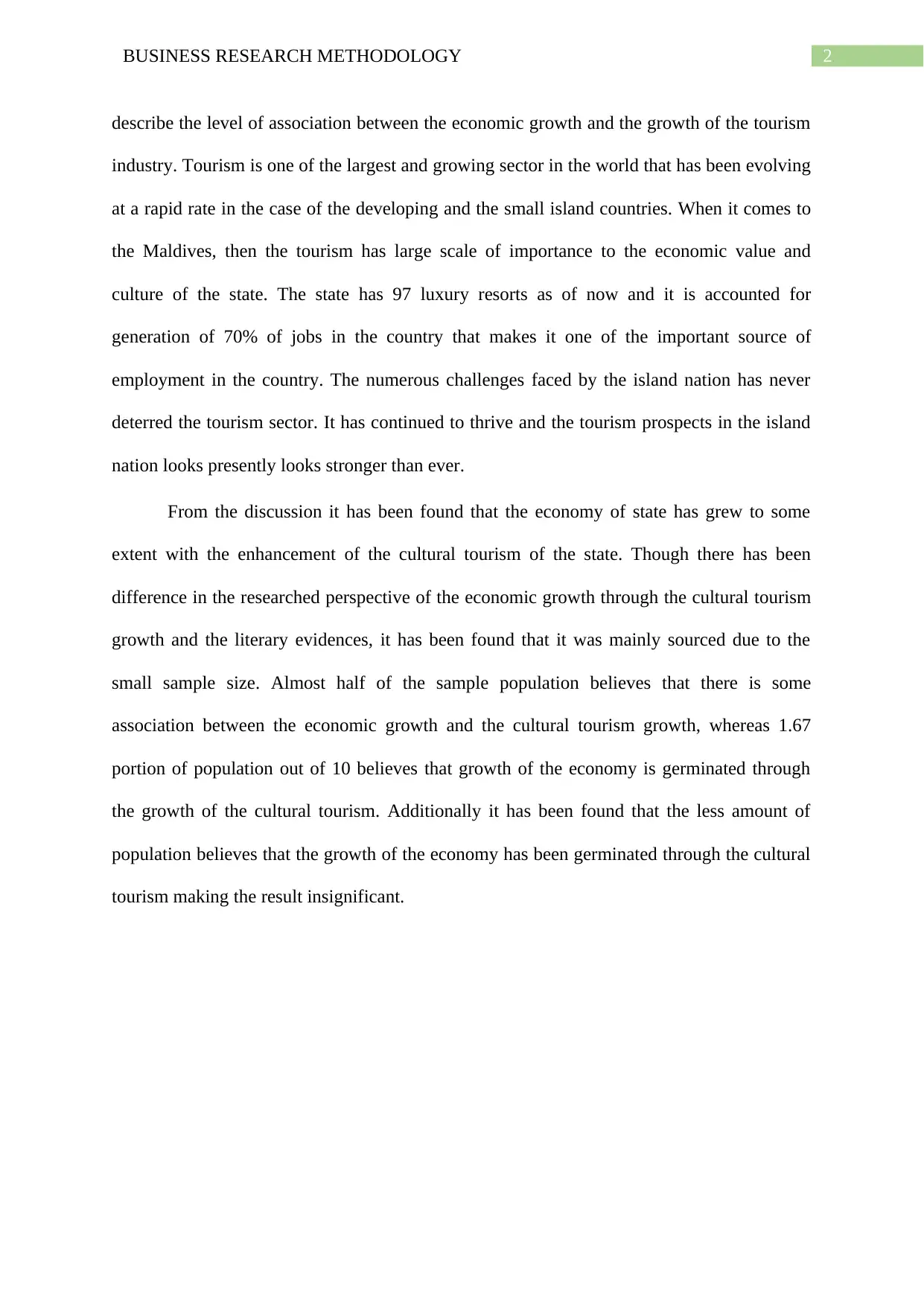
2BUSINESS RESEARCH METHODOLOGY
describe the level of association between the economic growth and the growth of the tourism
industry. Tourism is one of the largest and growing sector in the world that has been evolving
at a rapid rate in the case of the developing and the small island countries. When it comes to
the Maldives, then the tourism has large scale of importance to the economic value and
culture of the state. The state has 97 luxury resorts as of now and it is accounted for
generation of 70% of jobs in the country that makes it one of the important source of
employment in the country. The numerous challenges faced by the island nation has never
deterred the tourism sector. It has continued to thrive and the tourism prospects in the island
nation looks presently looks stronger than ever.
From the discussion it has been found that the economy of state has grew to some
extent with the enhancement of the cultural tourism of the state. Though there has been
difference in the researched perspective of the economic growth through the cultural tourism
growth and the literary evidences, it has been found that it was mainly sourced due to the
small sample size. Almost half of the sample population believes that there is some
association between the economic growth and the cultural tourism growth, whereas 1.67
portion of population out of 10 believes that growth of the economy is germinated through
the growth of the cultural tourism. Additionally it has been found that the less amount of
population believes that the growth of the economy has been germinated through the cultural
tourism making the result insignificant.
describe the level of association between the economic growth and the growth of the tourism
industry. Tourism is one of the largest and growing sector in the world that has been evolving
at a rapid rate in the case of the developing and the small island countries. When it comes to
the Maldives, then the tourism has large scale of importance to the economic value and
culture of the state. The state has 97 luxury resorts as of now and it is accounted for
generation of 70% of jobs in the country that makes it one of the important source of
employment in the country. The numerous challenges faced by the island nation has never
deterred the tourism sector. It has continued to thrive and the tourism prospects in the island
nation looks presently looks stronger than ever.
From the discussion it has been found that the economy of state has grew to some
extent with the enhancement of the cultural tourism of the state. Though there has been
difference in the researched perspective of the economic growth through the cultural tourism
growth and the literary evidences, it has been found that it was mainly sourced due to the
small sample size. Almost half of the sample population believes that there is some
association between the economic growth and the cultural tourism growth, whereas 1.67
portion of population out of 10 believes that growth of the economy is germinated through
the growth of the cultural tourism. Additionally it has been found that the less amount of
population believes that the growth of the economy has been germinated through the cultural
tourism making the result insignificant.
⊘ This is a preview!⊘
Do you want full access?
Subscribe today to unlock all pages.

Trusted by 1+ million students worldwide
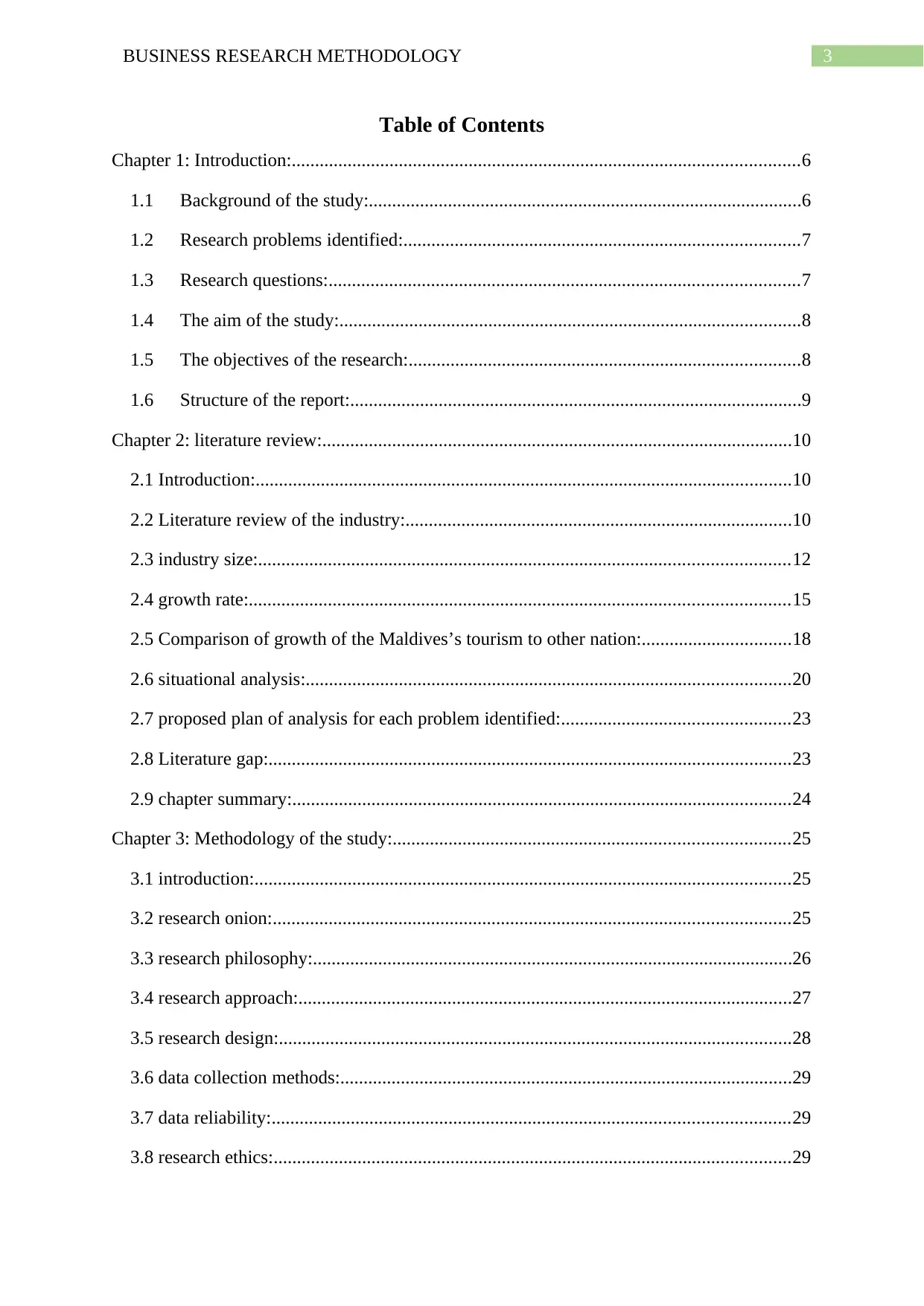
3BUSINESS RESEARCH METHODOLOGY
Table of Contents
Chapter 1: Introduction:.............................................................................................................6
1.1 Background of the study:.............................................................................................6
1.2 Research problems identified:.....................................................................................7
1.3 Research questions:.....................................................................................................7
1.4 The aim of the study:...................................................................................................8
1.5 The objectives of the research:....................................................................................8
1.6 Structure of the report:.................................................................................................9
Chapter 2: literature review:.....................................................................................................10
2.1 Introduction:...................................................................................................................10
2.2 Literature review of the industry:...................................................................................10
2.3 industry size:..................................................................................................................12
2.4 growth rate:....................................................................................................................15
2.5 Comparison of growth of the Maldives’s tourism to other nation:................................18
2.6 situational analysis:........................................................................................................20
2.7 proposed plan of analysis for each problem identified:.................................................23
2.8 Literature gap:................................................................................................................23
2.9 chapter summary:...........................................................................................................24
Chapter 3: Methodology of the study:.....................................................................................25
3.1 introduction:...................................................................................................................25
3.2 research onion:...............................................................................................................25
3.3 research philosophy:.......................................................................................................26
3.4 research approach:..........................................................................................................27
3.5 research design:..............................................................................................................28
3.6 data collection methods:.................................................................................................29
3.7 data reliability:...............................................................................................................29
3.8 research ethics:...............................................................................................................29
Table of Contents
Chapter 1: Introduction:.............................................................................................................6
1.1 Background of the study:.............................................................................................6
1.2 Research problems identified:.....................................................................................7
1.3 Research questions:.....................................................................................................7
1.4 The aim of the study:...................................................................................................8
1.5 The objectives of the research:....................................................................................8
1.6 Structure of the report:.................................................................................................9
Chapter 2: literature review:.....................................................................................................10
2.1 Introduction:...................................................................................................................10
2.2 Literature review of the industry:...................................................................................10
2.3 industry size:..................................................................................................................12
2.4 growth rate:....................................................................................................................15
2.5 Comparison of growth of the Maldives’s tourism to other nation:................................18
2.6 situational analysis:........................................................................................................20
2.7 proposed plan of analysis for each problem identified:.................................................23
2.8 Literature gap:................................................................................................................23
2.9 chapter summary:...........................................................................................................24
Chapter 3: Methodology of the study:.....................................................................................25
3.1 introduction:...................................................................................................................25
3.2 research onion:...............................................................................................................25
3.3 research philosophy:.......................................................................................................26
3.4 research approach:..........................................................................................................27
3.5 research design:..............................................................................................................28
3.6 data collection methods:.................................................................................................29
3.7 data reliability:...............................................................................................................29
3.8 research ethics:...............................................................................................................29
Paraphrase This Document
Need a fresh take? Get an instant paraphrase of this document with our AI Paraphraser
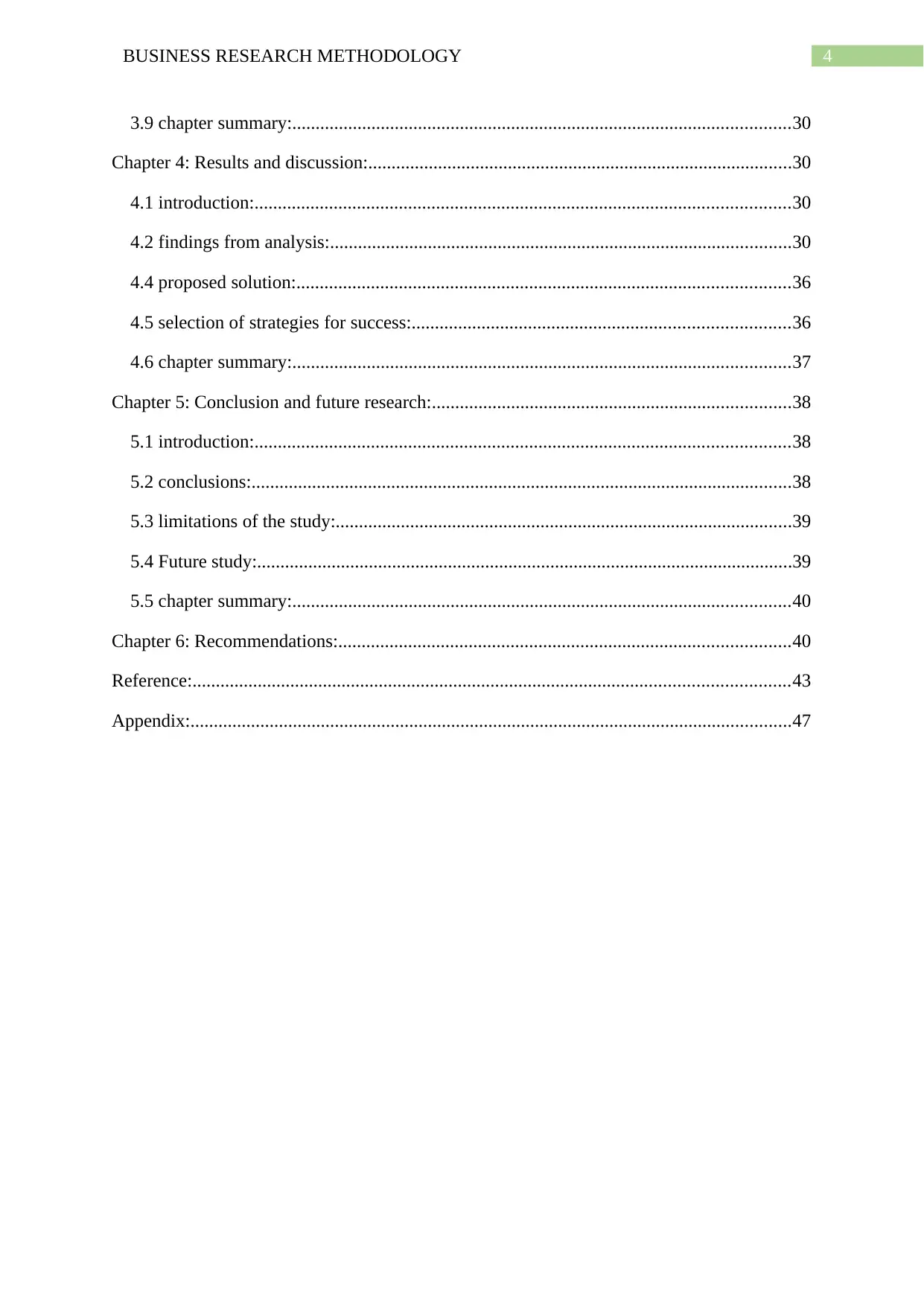
4BUSINESS RESEARCH METHODOLOGY
3.9 chapter summary:...........................................................................................................30
Chapter 4: Results and discussion:...........................................................................................30
4.1 introduction:...................................................................................................................30
4.2 findings from analysis:...................................................................................................30
4.4 proposed solution:..........................................................................................................36
4.5 selection of strategies for success:.................................................................................36
4.6 chapter summary:...........................................................................................................37
Chapter 5: Conclusion and future research:.............................................................................38
5.1 introduction:...................................................................................................................38
5.2 conclusions:....................................................................................................................38
5.3 limitations of the study:..................................................................................................39
5.4 Future study:...................................................................................................................39
5.5 chapter summary:...........................................................................................................40
Chapter 6: Recommendations:.................................................................................................40
Reference:................................................................................................................................43
Appendix:.................................................................................................................................47
3.9 chapter summary:...........................................................................................................30
Chapter 4: Results and discussion:...........................................................................................30
4.1 introduction:...................................................................................................................30
4.2 findings from analysis:...................................................................................................30
4.4 proposed solution:..........................................................................................................36
4.5 selection of strategies for success:.................................................................................36
4.6 chapter summary:...........................................................................................................37
Chapter 5: Conclusion and future research:.............................................................................38
5.1 introduction:...................................................................................................................38
5.2 conclusions:....................................................................................................................38
5.3 limitations of the study:..................................................................................................39
5.4 Future study:...................................................................................................................39
5.5 chapter summary:...........................................................................................................40
Chapter 6: Recommendations:.................................................................................................40
Reference:................................................................................................................................43
Appendix:.................................................................................................................................47
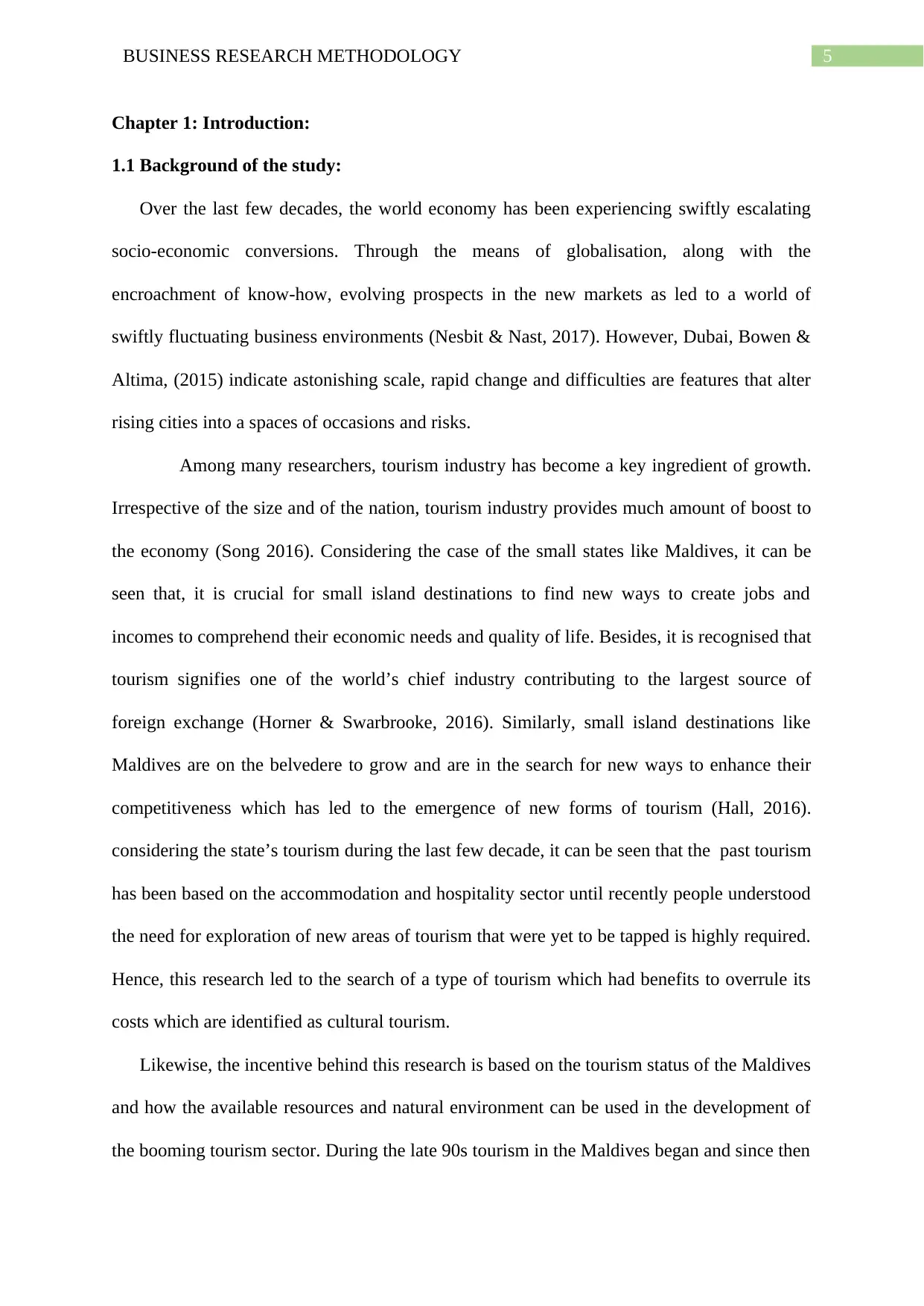
5BUSINESS RESEARCH METHODOLOGY
Chapter 1: Introduction:
1.1 Background of the study:
Over the last few decades, the world economy has been experiencing swiftly escalating
socio-economic conversions. Through the means of globalisation, along with the
encroachment of know-how, evolving prospects in the new markets as led to a world of
swiftly fluctuating business environments (Nesbit & Nast, 2017). However, Dubai, Bowen &
Altima, (2015) indicate astonishing scale, rapid change and difficulties are features that alter
rising cities into a spaces of occasions and risks.
Among many researchers, tourism industry has become a key ingredient of growth.
Irrespective of the size and of the nation, tourism industry provides much amount of boost to
the economy (Song 2016). Considering the case of the small states like Maldives, it can be
seen that, it is crucial for small island destinations to find new ways to create jobs and
incomes to comprehend their economic needs and quality of life. Besides, it is recognised that
tourism signifies one of the world’s chief industry contributing to the largest source of
foreign exchange (Horner & Swarbrooke, 2016). Similarly, small island destinations like
Maldives are on the belvedere to grow and are in the search for new ways to enhance their
competitiveness which has led to the emergence of new forms of tourism (Hall, 2016).
considering the state’s tourism during the last few decade, it can be seen that the past tourism
has been based on the accommodation and hospitality sector until recently people understood
the need for exploration of new areas of tourism that were yet to be tapped is highly required.
Hence, this research led to the search of a type of tourism which had benefits to overrule its
costs which are identified as cultural tourism.
Likewise, the incentive behind this research is based on the tourism status of the Maldives
and how the available resources and natural environment can be used in the development of
the booming tourism sector. During the late 90s tourism in the Maldives began and since then
Chapter 1: Introduction:
1.1 Background of the study:
Over the last few decades, the world economy has been experiencing swiftly escalating
socio-economic conversions. Through the means of globalisation, along with the
encroachment of know-how, evolving prospects in the new markets as led to a world of
swiftly fluctuating business environments (Nesbit & Nast, 2017). However, Dubai, Bowen &
Altima, (2015) indicate astonishing scale, rapid change and difficulties are features that alter
rising cities into a spaces of occasions and risks.
Among many researchers, tourism industry has become a key ingredient of growth.
Irrespective of the size and of the nation, tourism industry provides much amount of boost to
the economy (Song 2016). Considering the case of the small states like Maldives, it can be
seen that, it is crucial for small island destinations to find new ways to create jobs and
incomes to comprehend their economic needs and quality of life. Besides, it is recognised that
tourism signifies one of the world’s chief industry contributing to the largest source of
foreign exchange (Horner & Swarbrooke, 2016). Similarly, small island destinations like
Maldives are on the belvedere to grow and are in the search for new ways to enhance their
competitiveness which has led to the emergence of new forms of tourism (Hall, 2016).
considering the state’s tourism during the last few decade, it can be seen that the past tourism
has been based on the accommodation and hospitality sector until recently people understood
the need for exploration of new areas of tourism that were yet to be tapped is highly required.
Hence, this research led to the search of a type of tourism which had benefits to overrule its
costs which are identified as cultural tourism.
Likewise, the incentive behind this research is based on the tourism status of the Maldives
and how the available resources and natural environment can be used in the development of
the booming tourism sector. During the late 90s tourism in the Maldives began and since then
⊘ This is a preview!⊘
Do you want full access?
Subscribe today to unlock all pages.

Trusted by 1+ million students worldwide
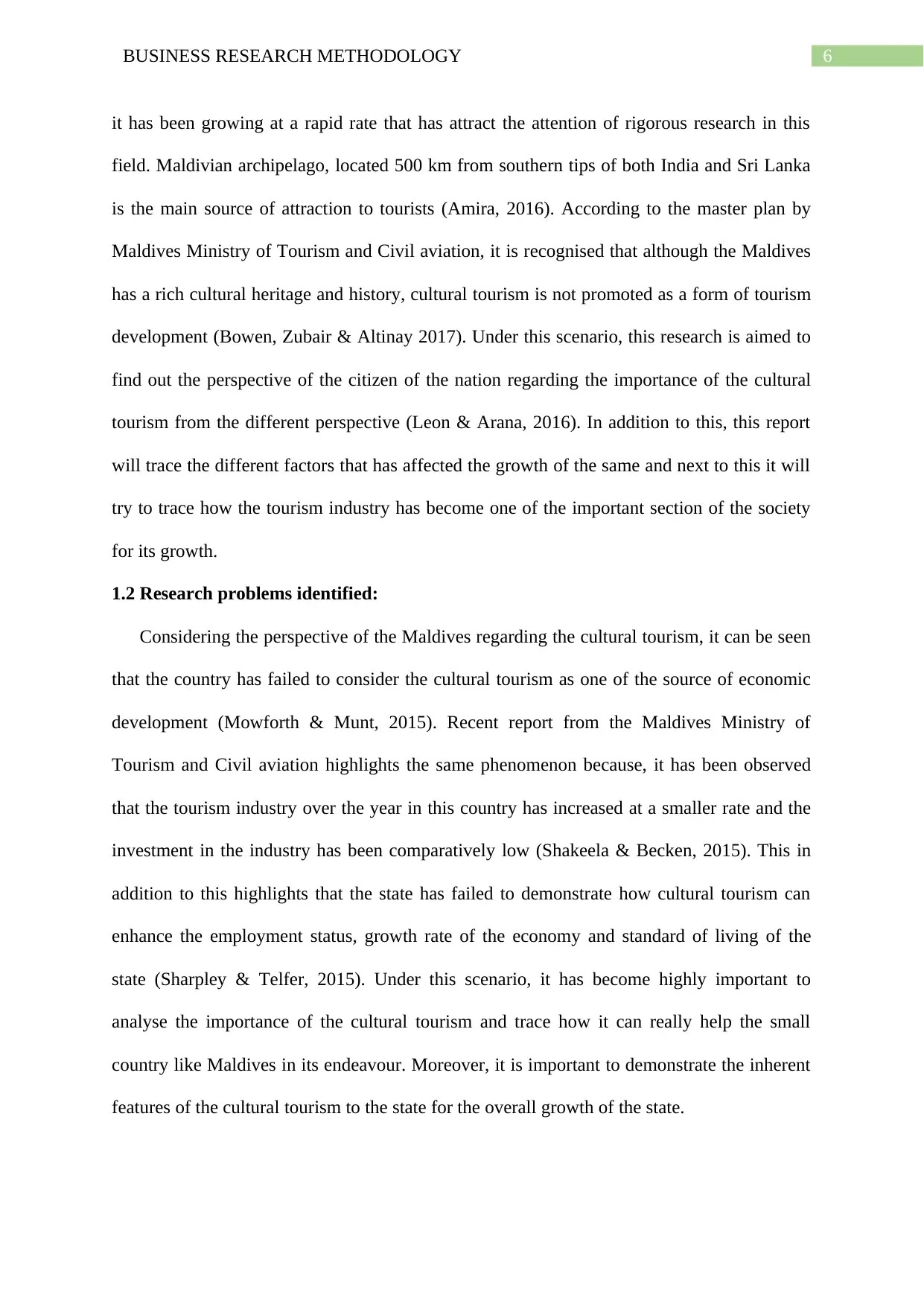
6BUSINESS RESEARCH METHODOLOGY
it has been growing at a rapid rate that has attract the attention of rigorous research in this
field. Maldivian archipelago, located 500 km from southern tips of both India and Sri Lanka
is the main source of attraction to tourists (Amira, 2016). According to the master plan by
Maldives Ministry of Tourism and Civil aviation, it is recognised that although the Maldives
has a rich cultural heritage and history, cultural tourism is not promoted as a form of tourism
development (Bowen, Zubair & Altinay 2017). Under this scenario, this research is aimed to
find out the perspective of the citizen of the nation regarding the importance of the cultural
tourism from the different perspective (Leon & Arana, 2016). In addition to this, this report
will trace the different factors that has affected the growth of the same and next to this it will
try to trace how the tourism industry has become one of the important section of the society
for its growth.
1.2 Research problems identified:
Considering the perspective of the Maldives regarding the cultural tourism, it can be seen
that the country has failed to consider the cultural tourism as one of the source of economic
development (Mowforth & Munt, 2015). Recent report from the Maldives Ministry of
Tourism and Civil aviation highlights the same phenomenon because, it has been observed
that the tourism industry over the year in this country has increased at a smaller rate and the
investment in the industry has been comparatively low (Shakeela & Becken, 2015). This in
addition to this highlights that the state has failed to demonstrate how cultural tourism can
enhance the employment status, growth rate of the economy and standard of living of the
state (Sharpley & Telfer, 2015). Under this scenario, it has become highly important to
analyse the importance of the cultural tourism and trace how it can really help the small
country like Maldives in its endeavour. Moreover, it is important to demonstrate the inherent
features of the cultural tourism to the state for the overall growth of the state.
it has been growing at a rapid rate that has attract the attention of rigorous research in this
field. Maldivian archipelago, located 500 km from southern tips of both India and Sri Lanka
is the main source of attraction to tourists (Amira, 2016). According to the master plan by
Maldives Ministry of Tourism and Civil aviation, it is recognised that although the Maldives
has a rich cultural heritage and history, cultural tourism is not promoted as a form of tourism
development (Bowen, Zubair & Altinay 2017). Under this scenario, this research is aimed to
find out the perspective of the citizen of the nation regarding the importance of the cultural
tourism from the different perspective (Leon & Arana, 2016). In addition to this, this report
will trace the different factors that has affected the growth of the same and next to this it will
try to trace how the tourism industry has become one of the important section of the society
for its growth.
1.2 Research problems identified:
Considering the perspective of the Maldives regarding the cultural tourism, it can be seen
that the country has failed to consider the cultural tourism as one of the source of economic
development (Mowforth & Munt, 2015). Recent report from the Maldives Ministry of
Tourism and Civil aviation highlights the same phenomenon because, it has been observed
that the tourism industry over the year in this country has increased at a smaller rate and the
investment in the industry has been comparatively low (Shakeela & Becken, 2015). This in
addition to this highlights that the state has failed to demonstrate how cultural tourism can
enhance the employment status, growth rate of the economy and standard of living of the
state (Sharpley & Telfer, 2015). Under this scenario, it has become highly important to
analyse the importance of the cultural tourism and trace how it can really help the small
country like Maldives in its endeavour. Moreover, it is important to demonstrate the inherent
features of the cultural tourism to the state for the overall growth of the state.
Paraphrase This Document
Need a fresh take? Get an instant paraphrase of this document with our AI Paraphraser
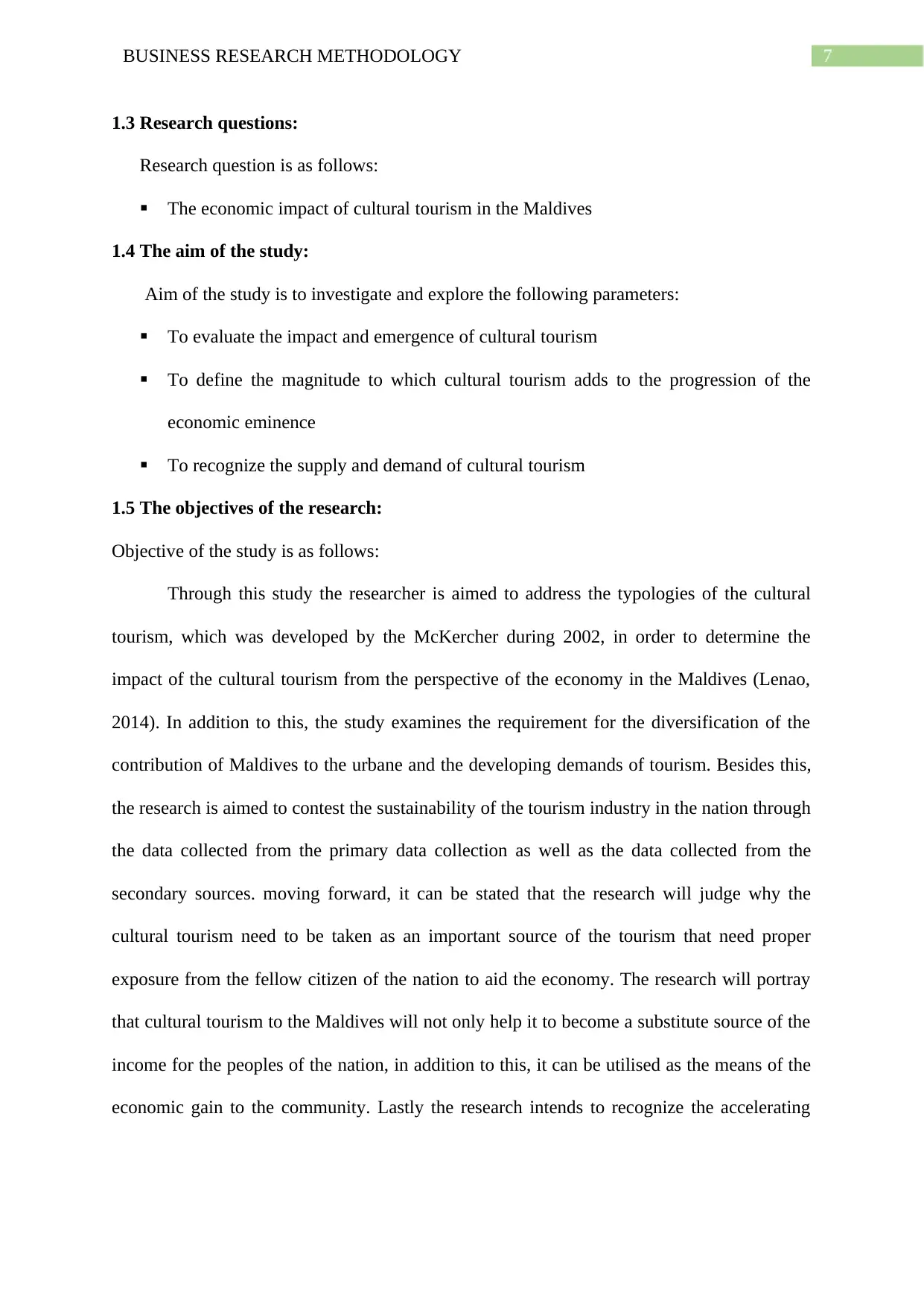
7BUSINESS RESEARCH METHODOLOGY
1.3 Research questions:
Research question is as follows:
The economic impact of cultural tourism in the Maldives
1.4 The aim of the study:
Aim of the study is to investigate and explore the following parameters:
To evaluate the impact and emergence of cultural tourism
To define the magnitude to which cultural tourism adds to the progression of the
economic eminence
To recognize the supply and demand of cultural tourism
1.5 The objectives of the research:
Objective of the study is as follows:
Through this study the researcher is aimed to address the typologies of the cultural
tourism, which was developed by the McKercher during 2002, in order to determine the
impact of the cultural tourism from the perspective of the economy in the Maldives (Lenao,
2014). In addition to this, the study examines the requirement for the diversification of the
contribution of Maldives to the urbane and the developing demands of tourism. Besides this,
the research is aimed to contest the sustainability of the tourism industry in the nation through
the data collected from the primary data collection as well as the data collected from the
secondary sources. moving forward, it can be stated that the research will judge why the
cultural tourism need to be taken as an important source of the tourism that need proper
exposure from the fellow citizen of the nation to aid the economy. The research will portray
that cultural tourism to the Maldives will not only help it to become a substitute source of the
income for the peoples of the nation, in addition to this, it can be utilised as the means of the
economic gain to the community. Lastly the research intends to recognize the accelerating
1.3 Research questions:
Research question is as follows:
The economic impact of cultural tourism in the Maldives
1.4 The aim of the study:
Aim of the study is to investigate and explore the following parameters:
To evaluate the impact and emergence of cultural tourism
To define the magnitude to which cultural tourism adds to the progression of the
economic eminence
To recognize the supply and demand of cultural tourism
1.5 The objectives of the research:
Objective of the study is as follows:
Through this study the researcher is aimed to address the typologies of the cultural
tourism, which was developed by the McKercher during 2002, in order to determine the
impact of the cultural tourism from the perspective of the economy in the Maldives (Lenao,
2014). In addition to this, the study examines the requirement for the diversification of the
contribution of Maldives to the urbane and the developing demands of tourism. Besides this,
the research is aimed to contest the sustainability of the tourism industry in the nation through
the data collected from the primary data collection as well as the data collected from the
secondary sources. moving forward, it can be stated that the research will judge why the
cultural tourism need to be taken as an important source of the tourism that need proper
exposure from the fellow citizen of the nation to aid the economy. The research will portray
that cultural tourism to the Maldives will not only help it to become a substitute source of the
income for the peoples of the nation, in addition to this, it can be utilised as the means of the
economic gain to the community. Lastly the research intends to recognize the accelerating
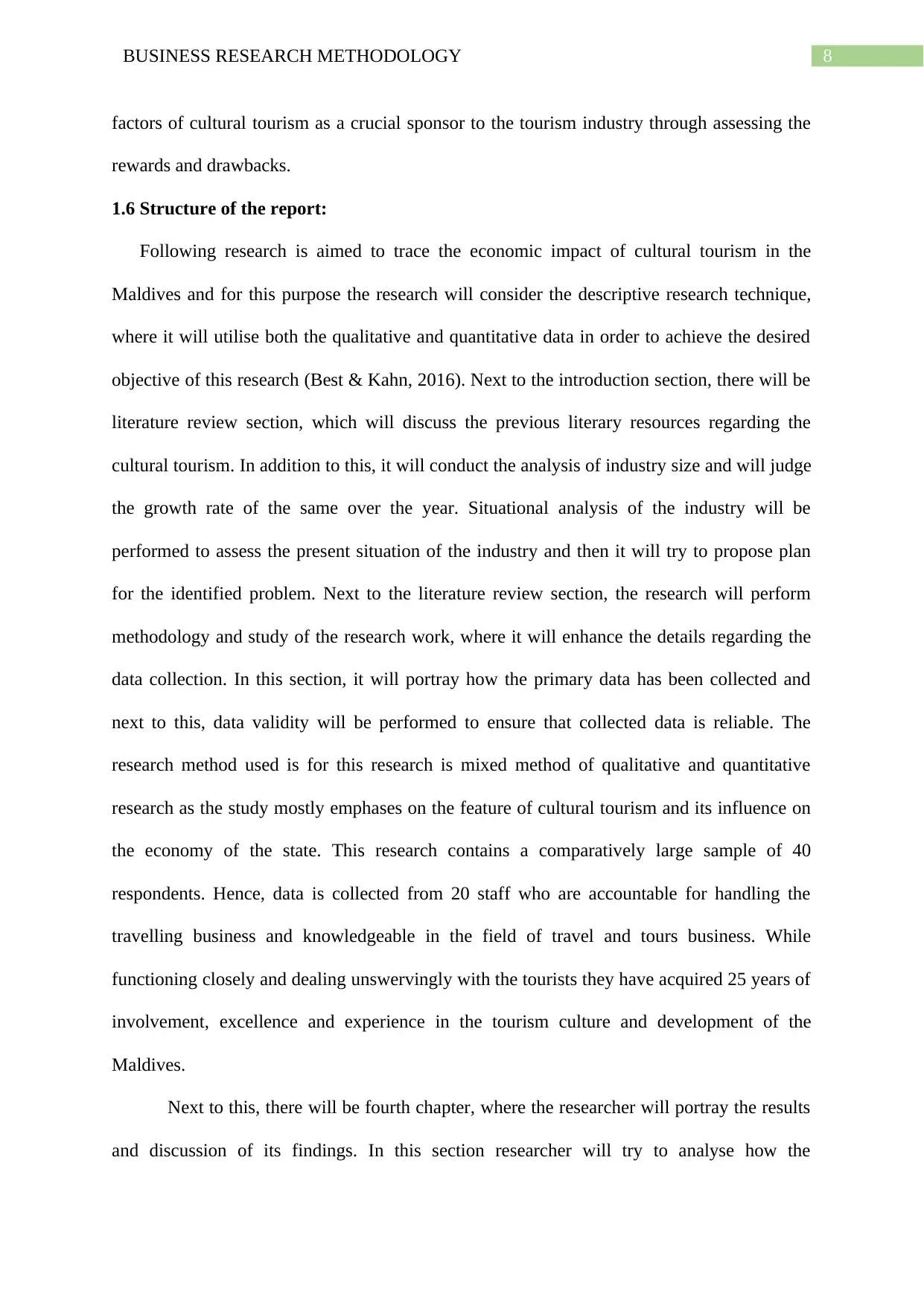
8BUSINESS RESEARCH METHODOLOGY
factors of cultural tourism as a crucial sponsor to the tourism industry through assessing the
rewards and drawbacks.
1.6 Structure of the report:
Following research is aimed to trace the economic impact of cultural tourism in the
Maldives and for this purpose the research will consider the descriptive research technique,
where it will utilise both the qualitative and quantitative data in order to achieve the desired
objective of this research (Best & Kahn, 2016). Next to the introduction section, there will be
literature review section, which will discuss the previous literary resources regarding the
cultural tourism. In addition to this, it will conduct the analysis of industry size and will judge
the growth rate of the same over the year. Situational analysis of the industry will be
performed to assess the present situation of the industry and then it will try to propose plan
for the identified problem. Next to the literature review section, the research will perform
methodology and study of the research work, where it will enhance the details regarding the
data collection. In this section, it will portray how the primary data has been collected and
next to this, data validity will be performed to ensure that collected data is reliable. The
research method used is for this research is mixed method of qualitative and quantitative
research as the study mostly emphases on the feature of cultural tourism and its influence on
the economy of the state. This research contains a comparatively large sample of 40
respondents. Hence, data is collected from 20 staff who are accountable for handling the
travelling business and knowledgeable in the field of travel and tours business. While
functioning closely and dealing unswervingly with the tourists they have acquired 25 years of
involvement, excellence and experience in the tourism culture and development of the
Maldives.
Next to this, there will be fourth chapter, where the researcher will portray the results
and discussion of its findings. In this section researcher will try to analyse how the
factors of cultural tourism as a crucial sponsor to the tourism industry through assessing the
rewards and drawbacks.
1.6 Structure of the report:
Following research is aimed to trace the economic impact of cultural tourism in the
Maldives and for this purpose the research will consider the descriptive research technique,
where it will utilise both the qualitative and quantitative data in order to achieve the desired
objective of this research (Best & Kahn, 2016). Next to the introduction section, there will be
literature review section, which will discuss the previous literary resources regarding the
cultural tourism. In addition to this, it will conduct the analysis of industry size and will judge
the growth rate of the same over the year. Situational analysis of the industry will be
performed to assess the present situation of the industry and then it will try to propose plan
for the identified problem. Next to the literature review section, the research will perform
methodology and study of the research work, where it will enhance the details regarding the
data collection. In this section, it will portray how the primary data has been collected and
next to this, data validity will be performed to ensure that collected data is reliable. The
research method used is for this research is mixed method of qualitative and quantitative
research as the study mostly emphases on the feature of cultural tourism and its influence on
the economy of the state. This research contains a comparatively large sample of 40
respondents. Hence, data is collected from 20 staff who are accountable for handling the
travelling business and knowledgeable in the field of travel and tours business. While
functioning closely and dealing unswervingly with the tourists they have acquired 25 years of
involvement, excellence and experience in the tourism culture and development of the
Maldives.
Next to this, there will be fourth chapter, where the researcher will portray the results
and discussion of its findings. In this section researcher will try to analyse how the
⊘ This is a preview!⊘
Do you want full access?
Subscribe today to unlock all pages.

Trusted by 1+ million students worldwide

9BUSINESS RESEARCH METHODOLOGY
perspective of the sample differs or infer with the literary ideas mentioned in the second
chapter. Lastly, there will be the fifth chapter that will be dedicated for the conclusion and
recommendations. In this section, the researcher will portray the conclusion of the research
and depict the action plan for the future developed in this regard. Next to this, limitation of
the research will be discussed and it will provide recommendation to enhance the finding in
the future researches.
Chapter 2: literature review:
2.1 Introduction:
Coverage of the economic implication of the tourism is one of the growing
sector that has been attracting the mind of the researchers since decades. Field of the
economic implication of the tourism is one of the sectors that has been influential since the
last two decades. Economic implication through the tourism is not a delineated matter and
various different scenarios overlap with each other consequently that makes it a
multidisciplinary issue, which is beyond the scope of a single research to interpret.
Considering the various literatures from the previous researches, it can be seen that the
researchers has segregated the economic implication of the tourism into two broad different
categories, which are developing and developed nation’s economic impact through the
tourism and the second one is the development of the small islands nation’s economic
implication through the tourism. This research is aimed to discuss the case of the Maldives,
where the cultural tourism is on rise during the last one decade due to its rich cultural heritage
along with the outstanding places to visit. Through this literature review section, the
researcher will provided detailed overview of the cultural tourism industry of the Maldives
and showcase the economic impact of the same on the country’s economy. Through the
analysis of the industry size, growth rate, situational analysis of the industry, this section will
perspective of the sample differs or infer with the literary ideas mentioned in the second
chapter. Lastly, there will be the fifth chapter that will be dedicated for the conclusion and
recommendations. In this section, the researcher will portray the conclusion of the research
and depict the action plan for the future developed in this regard. Next to this, limitation of
the research will be discussed and it will provide recommendation to enhance the finding in
the future researches.
Chapter 2: literature review:
2.1 Introduction:
Coverage of the economic implication of the tourism is one of the growing
sector that has been attracting the mind of the researchers since decades. Field of the
economic implication of the tourism is one of the sectors that has been influential since the
last two decades. Economic implication through the tourism is not a delineated matter and
various different scenarios overlap with each other consequently that makes it a
multidisciplinary issue, which is beyond the scope of a single research to interpret.
Considering the various literatures from the previous researches, it can be seen that the
researchers has segregated the economic implication of the tourism into two broad different
categories, which are developing and developed nation’s economic impact through the
tourism and the second one is the development of the small islands nation’s economic
implication through the tourism. This research is aimed to discuss the case of the Maldives,
where the cultural tourism is on rise during the last one decade due to its rich cultural heritage
along with the outstanding places to visit. Through this literature review section, the
researcher will provided detailed overview of the cultural tourism industry of the Maldives
and showcase the economic impact of the same on the country’s economy. Through the
analysis of the industry size, growth rate, situational analysis of the industry, this section will
Paraphrase This Document
Need a fresh take? Get an instant paraphrase of this document with our AI Paraphraser
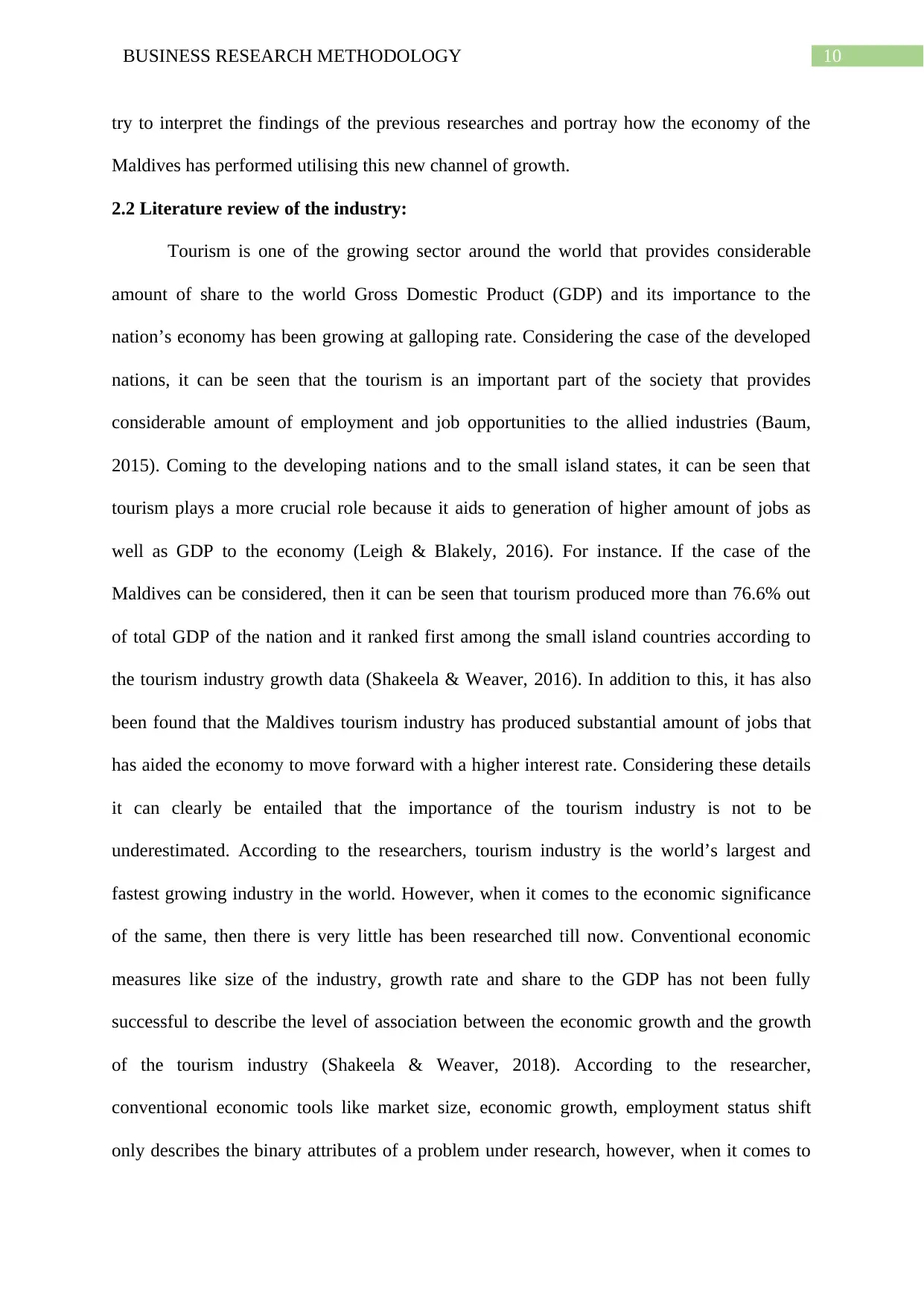
10BUSINESS RESEARCH METHODOLOGY
try to interpret the findings of the previous researches and portray how the economy of the
Maldives has performed utilising this new channel of growth.
2.2 Literature review of the industry:
Tourism is one of the growing sector around the world that provides considerable
amount of share to the world Gross Domestic Product (GDP) and its importance to the
nation’s economy has been growing at galloping rate. Considering the case of the developed
nations, it can be seen that the tourism is an important part of the society that provides
considerable amount of employment and job opportunities to the allied industries (Baum,
2015). Coming to the developing nations and to the small island states, it can be seen that
tourism plays a more crucial role because it aids to generation of higher amount of jobs as
well as GDP to the economy (Leigh & Blakely, 2016). For instance. If the case of the
Maldives can be considered, then it can be seen that tourism produced more than 76.6% out
of total GDP of the nation and it ranked first among the small island countries according to
the tourism industry growth data (Shakeela & Weaver, 2016). In addition to this, it has also
been found that the Maldives tourism industry has produced substantial amount of jobs that
has aided the economy to move forward with a higher interest rate. Considering these details
it can clearly be entailed that the importance of the tourism industry is not to be
underestimated. According to the researchers, tourism industry is the world’s largest and
fastest growing industry in the world. However, when it comes to the economic significance
of the same, then there is very little has been researched till now. Conventional economic
measures like size of the industry, growth rate and share to the GDP has not been fully
successful to describe the level of association between the economic growth and the growth
of the tourism industry (Shakeela & Weaver, 2018). According to the researcher,
conventional economic tools like market size, economic growth, employment status shift
only describes the binary attributes of a problem under research, however, when it comes to
try to interpret the findings of the previous researches and portray how the economy of the
Maldives has performed utilising this new channel of growth.
2.2 Literature review of the industry:
Tourism is one of the growing sector around the world that provides considerable
amount of share to the world Gross Domestic Product (GDP) and its importance to the
nation’s economy has been growing at galloping rate. Considering the case of the developed
nations, it can be seen that the tourism is an important part of the society that provides
considerable amount of employment and job opportunities to the allied industries (Baum,
2015). Coming to the developing nations and to the small island states, it can be seen that
tourism plays a more crucial role because it aids to generation of higher amount of jobs as
well as GDP to the economy (Leigh & Blakely, 2016). For instance. If the case of the
Maldives can be considered, then it can be seen that tourism produced more than 76.6% out
of total GDP of the nation and it ranked first among the small island countries according to
the tourism industry growth data (Shakeela & Weaver, 2016). In addition to this, it has also
been found that the Maldives tourism industry has produced substantial amount of jobs that
has aided the economy to move forward with a higher interest rate. Considering these details
it can clearly be entailed that the importance of the tourism industry is not to be
underestimated. According to the researchers, tourism industry is the world’s largest and
fastest growing industry in the world. However, when it comes to the economic significance
of the same, then there is very little has been researched till now. Conventional economic
measures like size of the industry, growth rate and share to the GDP has not been fully
successful to describe the level of association between the economic growth and the growth
of the tourism industry (Shakeela & Weaver, 2018). According to the researcher,
conventional economic tools like market size, economic growth, employment status shift
only describes the binary attributes of a problem under research, however, when it comes to
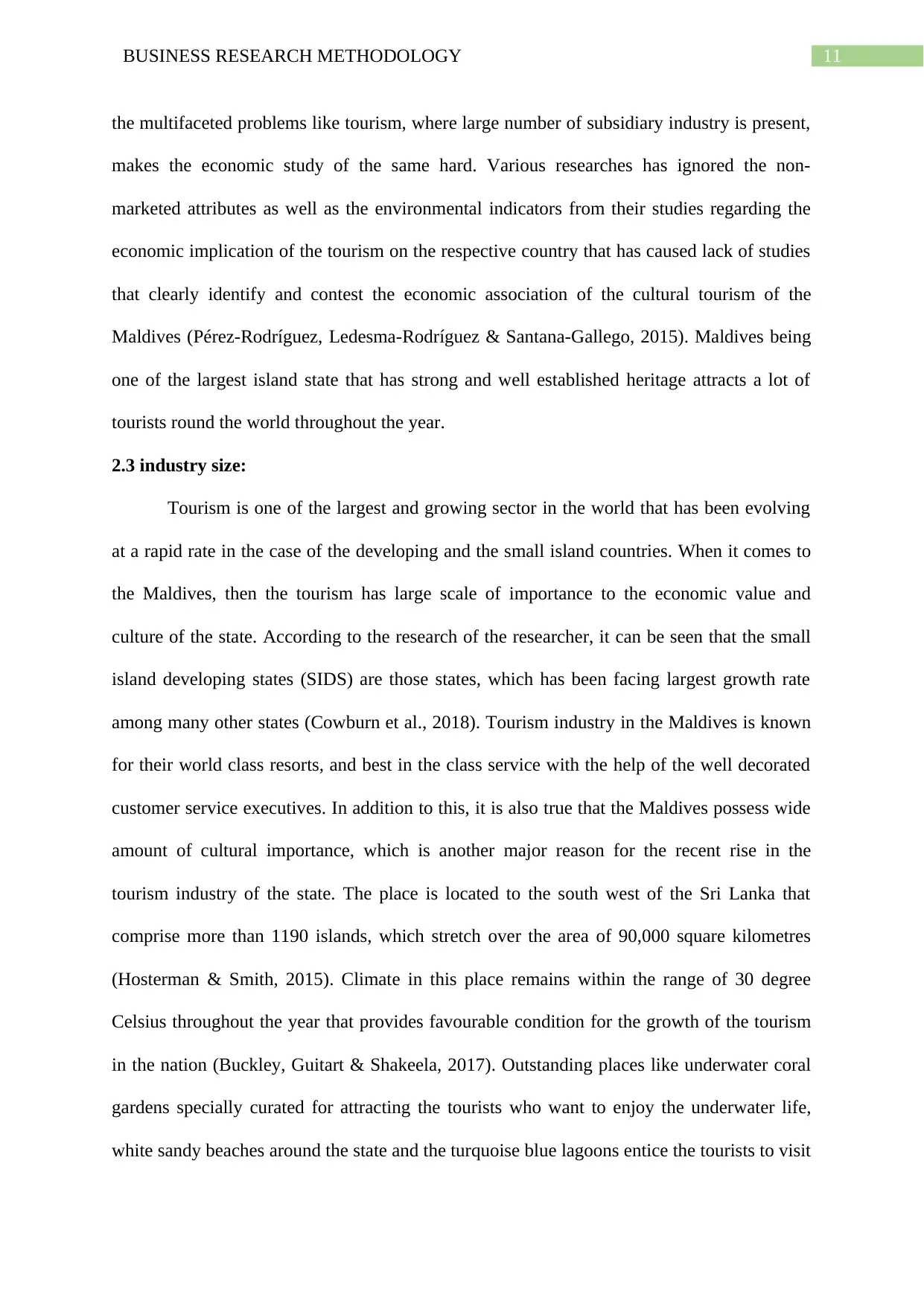
11BUSINESS RESEARCH METHODOLOGY
the multifaceted problems like tourism, where large number of subsidiary industry is present,
makes the economic study of the same hard. Various researches has ignored the non-
marketed attributes as well as the environmental indicators from their studies regarding the
economic implication of the tourism on the respective country that has caused lack of studies
that clearly identify and contest the economic association of the cultural tourism of the
Maldives (Pérez-Rodríguez, Ledesma-Rodríguez & Santana-Gallego, 2015). Maldives being
one of the largest island state that has strong and well established heritage attracts a lot of
tourists round the world throughout the year.
2.3 industry size:
Tourism is one of the largest and growing sector in the world that has been evolving
at a rapid rate in the case of the developing and the small island countries. When it comes to
the Maldives, then the tourism has large scale of importance to the economic value and
culture of the state. According to the research of the researcher, it can be seen that the small
island developing states (SIDS) are those states, which has been facing largest growth rate
among many other states (Cowburn et al., 2018). Tourism industry in the Maldives is known
for their world class resorts, and best in the class service with the help of the well decorated
customer service executives. In addition to this, it is also true that the Maldives possess wide
amount of cultural importance, which is another major reason for the recent rise in the
tourism industry of the state. The place is located to the south west of the Sri Lanka that
comprise more than 1190 islands, which stretch over the area of 90,000 square kilometres
(Hosterman & Smith, 2015). Climate in this place remains within the range of 30 degree
Celsius throughout the year that provides favourable condition for the growth of the tourism
in the nation (Buckley, Guitart & Shakeela, 2017). Outstanding places like underwater coral
gardens specially curated for attracting the tourists who want to enjoy the underwater life,
white sandy beaches around the state and the turquoise blue lagoons entice the tourists to visit
the multifaceted problems like tourism, where large number of subsidiary industry is present,
makes the economic study of the same hard. Various researches has ignored the non-
marketed attributes as well as the environmental indicators from their studies regarding the
economic implication of the tourism on the respective country that has caused lack of studies
that clearly identify and contest the economic association of the cultural tourism of the
Maldives (Pérez-Rodríguez, Ledesma-Rodríguez & Santana-Gallego, 2015). Maldives being
one of the largest island state that has strong and well established heritage attracts a lot of
tourists round the world throughout the year.
2.3 industry size:
Tourism is one of the largest and growing sector in the world that has been evolving
at a rapid rate in the case of the developing and the small island countries. When it comes to
the Maldives, then the tourism has large scale of importance to the economic value and
culture of the state. According to the research of the researcher, it can be seen that the small
island developing states (SIDS) are those states, which has been facing largest growth rate
among many other states (Cowburn et al., 2018). Tourism industry in the Maldives is known
for their world class resorts, and best in the class service with the help of the well decorated
customer service executives. In addition to this, it is also true that the Maldives possess wide
amount of cultural importance, which is another major reason for the recent rise in the
tourism industry of the state. The place is located to the south west of the Sri Lanka that
comprise more than 1190 islands, which stretch over the area of 90,000 square kilometres
(Hosterman & Smith, 2015). Climate in this place remains within the range of 30 degree
Celsius throughout the year that provides favourable condition for the growth of the tourism
in the nation (Buckley, Guitart & Shakeela, 2017). Outstanding places like underwater coral
gardens specially curated for attracting the tourists who want to enjoy the underwater life,
white sandy beaches around the state and the turquoise blue lagoons entice the tourists to visit
⊘ This is a preview!⊘
Do you want full access?
Subscribe today to unlock all pages.

Trusted by 1+ million students worldwide
1 out of 51
Related Documents
Your All-in-One AI-Powered Toolkit for Academic Success.
+13062052269
info@desklib.com
Available 24*7 on WhatsApp / Email
![[object Object]](/_next/static/media/star-bottom.7253800d.svg)
Unlock your academic potential
Copyright © 2020–2026 A2Z Services. All Rights Reserved. Developed and managed by ZUCOL.





